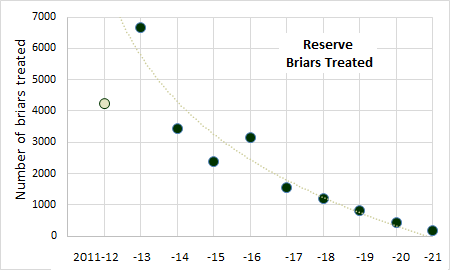fotpin News 2021
13 Nov 2021: Weeding Effort summary for the 2021-22 season, to October 31
The weeding effort for the 2021-22 season to the end of October was 141 hours, entirely within the Reserve (including the Extension). This was 31% less than last season but the second largest effort in the last 6 seasons. Strong weed growth in response to the second near-record rainfall year in a row really required more effort than this, but it was interrupted by the Covid-19 lockdown restrictions, shown clearly in the monthly effort chart. Judicious use of allowed exercise time prevented effort coming to a complete halt but there is still a lot to catch up on.
The inability to run our chosen weed control program, plus the unusual seasons requiring unusual practices means that many comparisons with previous seasons are misleading. Spraying Verbascum throughout winter (until lockdown) in order to catch up on last season's late germination and get ahead for this season resulted in Verbascum receiving 50% of the effort. The distribution of effort was skewed to those paddocks that did not have Verbascum treated at the end of last season.
See the weeding effort page and associated links to maps and charts for more statistics and comparisons with previous seasons and across the different management regions of the Reserve.
06 Oct 2021: Added historical aerial photographs of the reserve from 1940 to the present to the Pinnacle maps page
22 Sep 2021: 40-fold reduction in Sweet Briars achieved in 2021
One of the key woody weed targets for fotpin has been Sweet briar (Rosa rubignosa).
A systematic approach over 10 years has resulted in their average density across the Reserve* being reduced from 44 briars/ha in 2012-13 to 1.1 briars/ha in 2020-21. In this time more than 24,000 have been removed from the Reserve, mostly by spraying.
For more details see the briar eradication and briar density distribution pages.

* Note: this includes in the 2016 Pinnacle Extension, where treatment also began in 2012-13 because of its high conservation value
20 Sep 2021: Weeding effort summary for 2020-21 season
June 30 this year marked the end of the 11th season of closely recording, georeferencing and monitoring fotpin's weed control effort.
Features of the weeding effort summary for the 2020-21 season include:
- effort was the largest of the last 5 seasons, both for the Reserve* alone (794 hours) and for the Reserve and adjacent paddocks combined (802 hours);
- despite the increased effort this season we struggled to control many of the usual invasive weed targets, notably St. John's Wort and Verbascum;
- effort in Weetangera paddock has increased from 3% in 2011-14 of that spent in the Reserve to 38% in 2020-21;
- effort in the Reserve excluding the Weetangera paddock is the smallest of the 11 seasons;
- most effort was spent on: miscellaneous Broadleaf Weeds (215 hours), Verbascum (149 h), St. John's Wort (116 h) and Saffron Thistles (109 h). Together these accounted for 74% of total effort;
- only about 40% of effort was spent on weeds rated as high risk.
See the 2020-2021 weeding effort page and associated links to maps and charts for more statistics and comparisons with previous seasons and across the different management regions of the Reserve.
* Note: effort for the Reserve
now includes effort in the Extension, both in this season and in previous seasons.
24 Mar 2021: New invasive weed alert
"Sticky Nightshade"
02 Feb 2021: Weeding Effort summary for the 2020-21 season, to January 31
The weeding effort for the 2020-21 season to the end of January was 477 hours, entirely within the Reserve (including the Extension). This was 87% more than for this period last season but the fourth smallest total effort in the 11 seasons of records.
The increased effort compared to last season reflects the fact that 2020 was the fifth wettest year in the 47 years since BoM rainfall records commenced in this part of Canberra, and the wettest since 2016. It was also a warmer than average winter. These conditions were ideal for germination and growth of the many weed types present on the Reserve. (Fortunately conditions were also ideal for native species which have been present in abundance as well, with many species being observed for the first time in many years).
The increase compared with last season belies the fact that we have been unable to put in enough effort to control the weeds across the Reserve to the same extent as in most previous seasons. We have had reduced availability of weeders, and efforts have been affected by rain. The intense grass growth also means that weeding is much slower than usual.
See the weeding effort page and associated links to maps and charts for more statistics and comparisons with previous seasons and across the different management regions of the Reserve.
29 Jan 2021: Total number of native species recorded on The Pinnacle Nature Reserve reaches 720.
For earlier News articles, see News Archives for:



